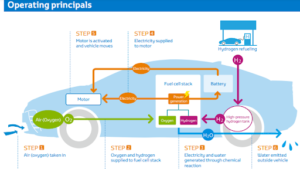In news– Recently, the Union Minister for Road, Transport and Highways has launched the world’s most advanced technology – developed green hydrogen Fuel Cell Electric Vehicle (FCEV), Toyota Mirai.
About FCEV Toyota’s Mirai-
- This is a first of its kind project in India which aims to create a Green Hydrogen based ecosystem in the country by creating awareness about the unique utility of Green Hydrogen and FCEV technology.
- Toyota Kirloskar Motor Pvt Ltd and International Center for Automotive Technology (ICAT) are conducting a Pilot Project to study and evaluate the world’s most advanced Fuel Cell Electric Vehicle (FCEV) Toyota Mirai which runs on hydrogen, on Indian roads and climatic conditions.
- The Toyota Fuel Cell System (TFCS) combines proprietary fuel cell technology that includes the Toyota FC Stack and high-pressure hydrogen tanks with the hybrid technology.
- The TFCS has high energy efficiency compared with conventional internal combustion engines, along with superior environmental performance highlighted by zero emissions of CO2 and other pollutants during vehicle operation.
- The hydrogen tanks can be refueled in approximately three minutes, and with an ample cruising range, the system promises convenience on par with gasoline engine vehicles.
- FCEV, powered by Hydrogen, is one of the best Zero Emission solutions as it is completely environmentally friendly with no tailpipe emissions other than water.
- It is an important initiative which will promote clean energy and environmental protection by reducing dependence on fossil fuels and thereby make India ‘Energy Self-reliant’ by 2047.

What is Green Hydrogen / Green Ammonia?
- Green hydrogen, also referred to as ‘clean hydrogen’ is produced by using electricity from renewable energy sources, such as solar or wind power, abundantly available biomass, to split water into two hydrogen atoms and one oxygen atom through a process called electrolysis.
- The hydrogen thus produced is used in the manufacturing process and oxygen is released into the atmosphere or bottled and sold to hospitals and industries that need it.
- A similar process also helps produce green ammonia.
- Ammonia is a pungent gas that is widely used to make agricultural fertilisers.
- Green ammonia production is where the process of making ammonia is 100% renewable and carbon-free.
- One way of making green ammonia is by using hydrogen from water electrolysis and nitrogen separated from the air.
- Introduction and adoption of technology to tap into the green hydrogen’s potential will play a key role in securing a clean and affordable energy future for India.
















